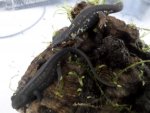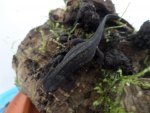- Joined
- May 8, 2013
- Messages
- 2,685
- Reaction score
- 91
- Points
- 48
- Location
- Chesterfield, England
- Country
- England
Earlier this year I was offered a group of three baby C. ensicauda (cheers Aaron), so I shoehorned yet another enclosure into the gap left open when some terrestrial Alpines I was raising went aquatic.
Unfortunately though, the smallest one just wouldn't put weight on and eventually died. I tried everything I could think of including different temps, different foods aquatic and terrestrial set ups, and separating it from the other two in case there was some kind of pecking order. Even bathing it in diluted Bacyfec didn't work the miracle it has in the past with sickly Tylototriton and C. pyrrhos. It's never nice losing babies, but I was especially gutted this time because C. ensicauda don't grow on trees any more and also because my chances of getting both sexes have come down quite a bit now as well.
Thankfully the remaining two have done very well on a diet of chopped nightcrawler, fruit flies and whiteworms, and the characteristic gold/green splodges are just starting to appear on their flanks and limbs.
I'm still hopeful they are a pair because they have different body to tail length ratios, but I'm not sure how accurate sexing such young newts is using that method so I'm keeping everything crossed at the moment!
Unfortunately though, the smallest one just wouldn't put weight on and eventually died. I tried everything I could think of including different temps, different foods aquatic and terrestrial set ups, and separating it from the other two in case there was some kind of pecking order. Even bathing it in diluted Bacyfec didn't work the miracle it has in the past with sickly Tylototriton and C. pyrrhos. It's never nice losing babies, but I was especially gutted this time because C. ensicauda don't grow on trees any more and also because my chances of getting both sexes have come down quite a bit now as well.
Thankfully the remaining two have done very well on a diet of chopped nightcrawler, fruit flies and whiteworms, and the characteristic gold/green splodges are just starting to appear on their flanks and limbs.
I'm still hopeful they are a pair because they have different body to tail length ratios, but I'm not sure how accurate sexing such young newts is using that method so I'm keeping everything crossed at the moment!
















